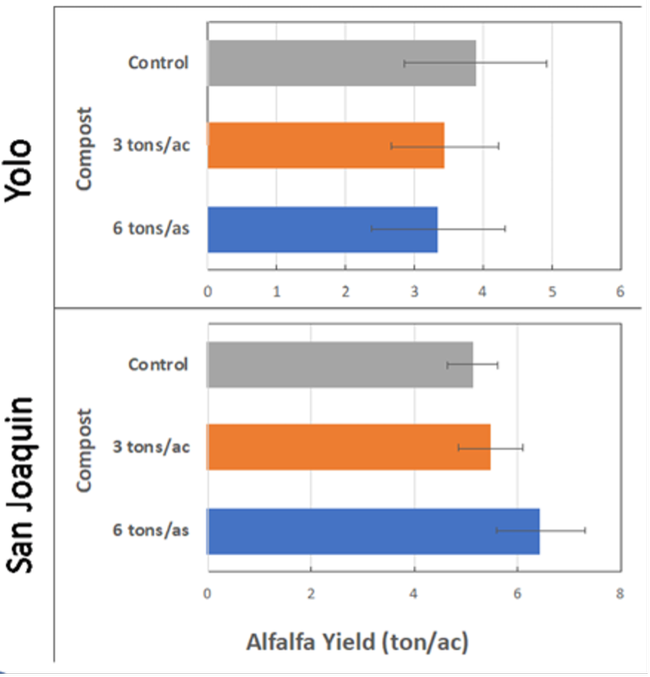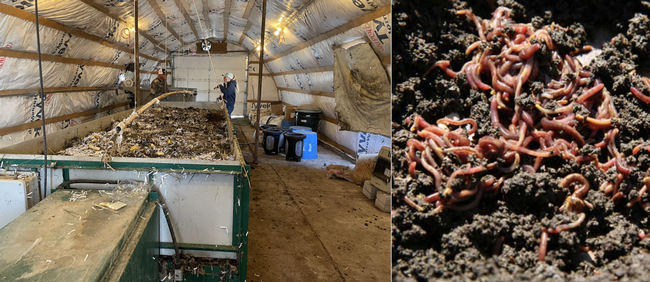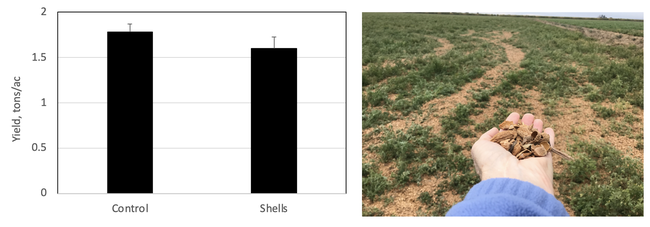Healthy soils are key for ensuring optimum plant health for high quality, high yielding alfalfa stands, not to mention long-term crop production.
What is meant by 'healthy soils'? Those soil which continually improve in the structure, organic matter, aeration and ability to nurture plant growth are key attributes. Soil 'tilth' is another word for the 'crumbliness' and excellent structure of the soil which allows good water retention, drainage, fertility, and aeration. To improve soil health we need to addressing some of the problems commonly seen in alfalfa fields such as compaction, lack of aeration, poor drainage, which in turn lead to poor root growth and low yield. What are the strategies?
NOTE: FIELD MEETING ON COMPOST IN ALFALFA TO BE HELD 28 July in the Delta of San Joaquin County, CA See POST.
KEY ISSUES AND APPROACHES
Soil compaction has probably been one of the biggest challenges for alfalfa and other crops, particularly in the Sacramento Valley where there are some relatively high clay content soils. Equipment traveling across fields, especially when soils are wet, often causes significant compaction issues resulting in reduced alfalfa yields, stand losses, and other soil health challenges, like poor water infiltration and microbial activity. For annual crops affected by soil compaction, a cultivation serves to open up the ground and bringing air to plant roots to help improve plant health, but of course it is not possible with alfalfa.
What can be done to alleviate soil compaction issues?
Short term solution. Prior to planting, chiseling, and ripping fields is essential for breaking hard pans to ensure healthy root systems during stand establishment for high yielding, high-quality alfalfa hay. Fields should be ripped to depth of at least 18-24-inches deep prior to planting. The biggest challenge with this practice is cost, which can run in the tens of thousands of dollars for groundwork, especially with current fuel prices (UC ANR Cost and Returns for alfalfa).
Traffic. Our experiments show at least 25% reduction in yields due to field traffic. Take steps to reduce traffic during harvest periods, particularly baling and bale pickup. Equipment which collects bales during baling and deposits them at the field edge saves one operation per harvest. Longer-term 'controlled traffic', if feasible can help. Traffic on wet soils is particularly harmful.
Long term solutions. Anything that adds organic matter to the soil will improve soil health. This includes compost, compost tea, cover crops, mulches, and residual plant material after harvest, like corn stalks and wheat straw (Light 2018). Organic matter provides food for soil microbes, resulting in increased microbial activity, which leads to improved soil structure, better nutrient and water retention, increased water infiltration, and soil carbon (C) sequestration (Fig. 1).
Figure 1. Model for healthy soils leading to healthy plants. Signs of healthy soils include better water infiltration, higher organic matter, and improved microbial activity.
What about Addition of Organic Matter?
Compost. This material is decomposed organic matter from plants or animals (e.g. manures). Plant-derived composts have a high carbon-to-nitrogen ratio (C:N), which is the relative amount of carbon and nitrogen in the material. Animal-derived composts have a low C:N. The ratio is important because it affects microbial activity and plant-available nitrogen. With a grant from CDFA (CA Dept Food &Ag), we've been looking at the benefits of compost applications in alfalfa hay in Yolo and San Joaquin counties. We applied high C:N green waste compost to alfalfa at 3 and 6 tons per acre in the fall of 2020 and 2021 and then flood irrigated the field. We took yields the following spring in 2021, an indicator of improved soil health.
2021 Research Results from Compost Applications
Results for 2021 showed higher carbon respiration in the compost treated plots, documenting increased microbial activity. Microbes build soils, and higher activity typically signals improvements to soil structure such as improved infiltration rates, increased water holding capacity and reduced compaction. IN this one-year experiment, there were no significant differences in yields, although there was a trend towards higher yields in San Joaquin Co., but lower in Yolo Co, (Fig. 2). The rate at which microbes use up compost depends on a number of factors like soil moisture, texture, and temperature; in alfalfa, it's probably 85-90% per year.
Being Patient. One of the challenges with compost is that can take years for benefits to show in terms of increased yields and forage quality. In addition, costs for material plus hauling runs $27/ton and spreading $10/ton, totaling $37/ton (2021 prices). To help offset compost costs, CDFA's Healthy Soils Program provides funding to farmers for implementing soil conservation practices like compost applications. The application process is expected to open in the fall of 2022, https://www.cdfa.ca.gov/oefi/healthysoils/. The website includes technical assistance resources for more information.
Figure 2. Response of alfalfa yield to applications of compost at sites in Yolo Co. and San Joaquin Co., CA in a one-year study in 2021.
Compost teas. This product is a liquid version of the solid compost material which contains soluble organic matter, plant nutrients, and beneficial microorganisms. Compost teas tend to be more expensive per acre than compost because of additional processing. In alfalfa, single year UCCE trials evaluating the impact of microbial stimulants in alfalfa production in established stands on yield increases have met with limited success. This isn't surprising given that healthy plants with deep taproots are likely extracting needed nutrients in the soil.
In addition, it can take years to build up organic matter and see associated benefits of increased microbial activity in soils for improved plant health. For example, Fulstone Ranches, Smith Valley, NV has been applying compost tea (extracted from worm castings from their vermiculture operation, Photo 1) to their alfalfa fields twice a year since 2016. Benefits they're reporting include increased earthworm activity in treated fields, earlier snowmelt from enhanced microbial activity, better water infiltration, healthier plants that resist pests, and higher forage quality (Figure 3., Hay and Forage Grower, 2022).
Figure 3. Fulstone Ranch in Nevada produces compost teas for field application.
Mulches. These are materials such as decaying leaves and bark that are spread on the soil around plants to protect and enrich the soil. For the past year with support from CAFA (CA Alfalfa & Forage Assoc) we've been evaluating the use of almond shell byproducts on alfalfa in Yolo Co. as a way to manage almond shell waste along with possible benefits such as soil moisture retention, weed control, and nutrient enrichment.
2021-22 Research Results from almond Shell Applications
Almond shells are high in Carbon, low in Nitrogen (C:N ratio), so will immobilize some soil N. However, this should not be a problem for alfalfa since it's a legume and fixes N. This unique feature of alfalfa means that one can apply high C:N amendments to alfalfa in crop rotations giving farmers more options for managing high carbon ag by-products like almond shells. In addition, since the shells aren't incorporated, any N tied up will be slow and only on the surface. Shells also have some K (potassium), about 29 lbs/ton (35 lb K20/ton), which can be eventually leached with rain or flood irrigation, enhancing plant nutrition.
In the fall of 2021, we applied almond shells to an alfalfa stand at 4-8 tons/ac (8 tons/acre giving about a ½-in cover). One of the challenges of spreading shells is that they're so light that it's hard to assess application rates. By spring, the shells had ‘melted' into the ground, and it was hard to tell where applications occurred. First cut yields and stand counts in 2022 were not significantly different for almond shell mulches versus untreated control plots (Fig. 3). Although weed pressure was light, there appeared to be some benefit of the almond shell mulch on suppressing weeds. In the fall of 2022, we'll apply another application of almond shells and measure additional benefits including soil moisture retention.
Figure 4. First-cut 2022 response of alfalfa yields to application of almond shells applied in 2021, Yolo Co., CA.
Summary: Although there are few magic solutions to improving soil health, improved soil prep to break up subsurface layers, considerations of additions of organic matter, and attempts made to reduce field traffic should be considered. Let's remember that a high-yielding, deep rooted alfalfa crop is likely to contribute significant organic matter to soils, often more than applications of manures or compost. Vigorous alfalfa improves soil tilth due to development of deep root channels and significant root and rhizosphere activity. Thus, all those steps which improve yield (such as timeliness of planting, good stand establishment, good varieties, weed & pest management, long cutting schedules, good irrigation practices) are also likely to improve soil health.
Additional reading:
Magdoff F and H van Es. 2021. Building better soils for better crops. Ecological management for healthy soils. 4th edition, SARE.
UC ANR Sample costs to establish and produce alfalfa hay. 2020. Sacramento and Northern San Joaquin Valley, https://coststudies.ucdavis.edu/en/current/.
Hay and Forage Grower. 2022. Worming their way to better hay, https://hayandforage.com/print-article-3935-permanent.html, April-May Issue.
Light S. 2018. Strategies to avoid and manage soil compaction. https://ucanr.edu/blogs/blogcore/postdetail.cfm?postnum=27421



